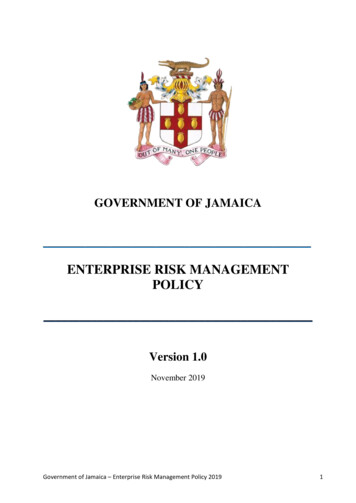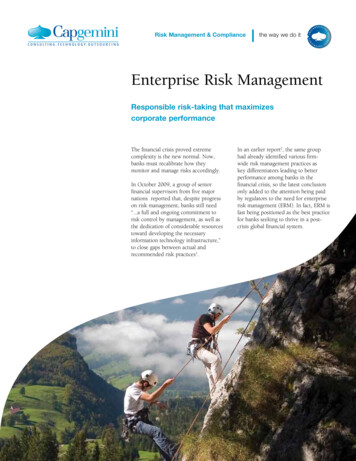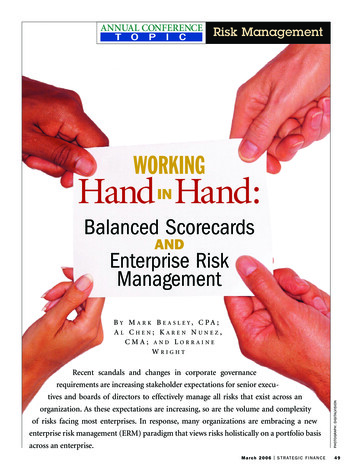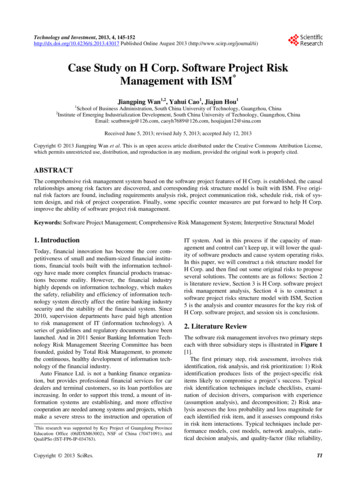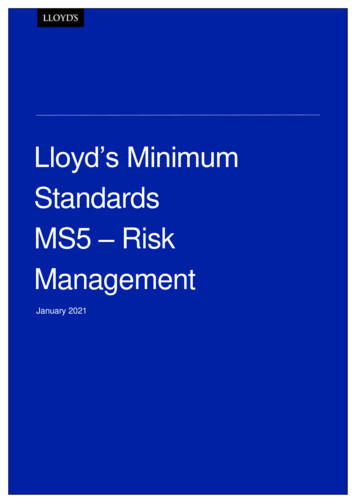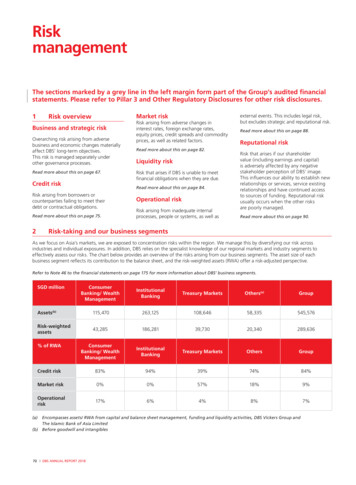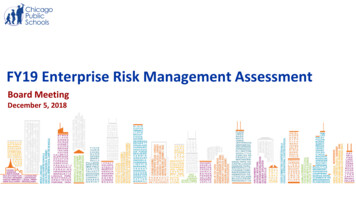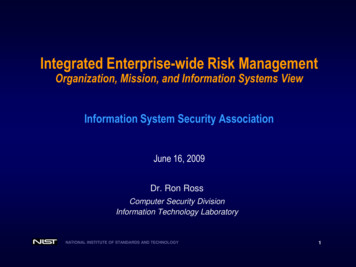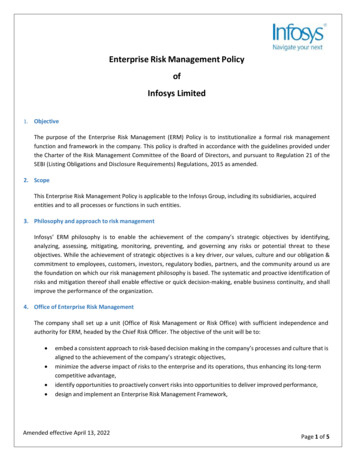
Transcription
Enterprise Risk Management PolicyofInfosys Limited1.ObjectiveThe purpose of the Enterprise Risk Management (ERM) Policy is to institutionalize a formal risk managementfunction and framework in the company. This policy is drafted in accordance with the guidelines provided underthe Charter of the Risk Management Committee of the Board of Directors, and pursuant to Regulation 21 of theSEBI (Listing Obligations and Disclosure Requirements) Regulations, 2015 as amended.2. ScopeThis Enterprise Risk Management Policy is applicable to the Infosys Group, including its subsidiaries, acquiredentities and to all processes or functions in such entities.3. Philosophy and approach to risk managementInfosys’ ERM philosophy is to enable the achievement of the company’s strategic objectives by identifying,analyzing, assessing, mitigating, monitoring, preventing, and governing any risks or potential threat to theseobjectives. While the achievement of strategic objectives is a key driver, our values, culture and our obligation &commitment to employees, customers, investors, regulatory bodies, partners, and the community around us arethe foundation on which our risk management philosophy is based. The systematic and proactive identification ofrisks and mitigation thereof shall enable effective or quick decision-making, enable business continuity, and shallimprove the performance of the organization.4. Office of Enterprise Risk ManagementThe company shall set up a unit (Office of Risk Management or Risk Office) with sufficient independence andauthority for ERM, headed by the Chief Risk Officer. The objective of the unit will be to: embed a consistent approach to risk-based decision making in the company’s processes and culture that isaligned to the achievement of the company’s strategic objectives,minimize the adverse impact of risks to the enterprise and its operations, thus enhancing its long-termcompetitive advantage,identify opportunities to proactively convert risks into opportunities to deliver improved performance,design and implement an Enterprise Risk Management Framework,Amended effective April 13, 2022Page 1 of 5
monitor the key risks to the enterprise and associated mitigation plans, and report these to the ExecutiveLeadership and the Risk Management Committee of the Board of Directors.The unit will work closely with other related risk management functions of the company such as legal, informationsecurity, finance, data privacy etc.5. Enterprise Risk Management FrameworkThe company shall define an Enterprise Risk Management Framework that is based on industry standards andencompassing all risks that the organization is facing internally or externally under different categories such asstrategic, operational, sectoral, legal and compliance risks including ESG and Cyber security risks. The frameworkshall prescribe detailed procedures and guidelines for contextualization of risks by linking it to strategic objectives,identification, assessment, mitigation, any internal controls, communication, monitoring and governance.Appropriate risk indicators shall be used to identify risks proactively. The framework shall take cognizance of risksfaced by key stakeholders and the multiplied impact of the same on the organization which may impact businesscontinuity while framing risk responses.Risk management is a decision-enabler which not only seeks to minimize the impact of risks but also enableseffective resource allocation based on the risk impact ranking and risk appetite. Strategic decisions are taken aftercareful consideration of risks and opportunities. The framework shall prescribe approaches to identify and measureprimary, secondary, consequential, and residual risks which will enable efficient decision making.Amended effective April 13, 2022Page 2 of 5
The salient components of the company’s Risk Management Framework are illustrated below:6. Enterprise Risk Management RolloutAchieving strategic objectives by proactively managing the risks shall be the responsibility of the company’sManagement at all levels. Risk management shall be embedded into day to day decision making of every functionof the company. People at different levels shall identify and manage the risks within their purview. Identificationof risks and bubbling up to the right decision makers shall be actively encouraged and different forums shall beprovided for such discussions.Functions across sales, delivery and business enablers including those in various geographies shall be included inthe roll out of the risk management program. Subsidiaries and acquired entities shall also adopt the group’s RiskManagement Framework and report accordingly. Processes put in place by the Risk Office shall duly enableidentification and assessment of top-down and bottom-up risks.The Risk Office shall have access and visibility to various parts of the organization and data that is required toenable effective risk management.Amended effective April 13, 2022Page 3 of 5
The ERM program shall be automated with an effective GRC (Governance, Risk and Compliance) solution toenable better visibility, tracking and governance. The program and associated systems shall be updated to adoptand/or comply to applicable regulations, if any.7. Risk Culture and AdoptionWhile a top down mandate is required to implement ERM, having a conducive risk culture will ingrain it intovarious parts of the organization. To achieve that, Management and the Risk Office shall demonstrate thebenefits of having an effective ERM program and encourage business leaders to proactively identify risks orchallenges. There shall be free and open forums at various levels in the organization to discuss risks or challengesto the business, bubbling up to the right level of leadership. Business leaders shall take the responsibility forproactively managing the risks and achieve the stated goals8. Aligning Enterprise Risk Management with other lines of defenseEnterprise Risk Management is an umbrella function looking into various aspects of risks from strategic,operational, financial, and tactical perspective. Risk office enables identification of potential risks and mitigationplans. In addition to Risk Office, there are other risk identification / mitigation functions which are working andsafeguarding the organizations assets such as audit, business continuity, compliance, information security, dataprivacy etc. The Risk Office shall align with these functions and exchange information where required to ensureall pertinent risks are captured and comprehensive solutions are implemented.9. GovernanceThe Enterprise Risk Management Framework shall provide for comprehensive governance detailing the structure,participants, charter, roles and responsibilities, periodicity of meetings and broad contours of the topics that canbe discussed in these meetings. The governance structures shall enable oversight on various risks and allow forbubbling up of risks to the right level of leadership including to the Risk Management Committee of the Board.10.Periodic maturity assessment, improvement, and innovationPeriodic assessment of the Enterprise Risk Management framework, function, mapping against any available riskmaturity models and identifying the areas of improvement shall be done to ensure continued relevance ofprogram and framework to the organization. Such review and assessment shall be carried out in at least onceevery two years by the Risk Office in accordance with the directions given by the Risk Management Committee.11.Review and approval of the policyThe Chief Risk Officer shall propose this policy or any changes to this policy to the Executive Leadership and to theRisk Management Committee of the Board of Directors. This policy shall become effective upon their approval.This policy shall be reviewed as deemed necessary by the Risk Management Committee and at least once in twoyears.Amended effective April 13, 2022Page 4 of 5
12.13.Terms used in this documentPrimary Riskis any uncertainty, event and/or scenario that may inhibit or prevent the organizationfrom achieving its stated business goals, vision and mission.Secondary Riskis any risk that inhibits the implementation of identified mitigation strategies andcontrols.Residual Riskis the risk that remains after risk treatment.Consequential Riskis an unintended consequence of implementing mitigation actions for primary risks.Risk Rankingis the ranking given to a risk based on impact of occurrence, likelihood of occurrenceand detectability. Risks are ranked as Critical, High, Medium or Low.Risk Appetiteis the amount of risk or exposure the organization is willing to accept in pursuit of itsgoals.Executive Leadershipare the Chief Executive Officer, Presidents, Chief Financial Officer, Group GeneralCounsel and Group Head of Human Resources of the Company.Lines of Defenserefers to risk assessment done by functions/units, corporate audit teams and externalaudit teamsReferences and ter.pdfAmended effective April 13, 2022Page 5 of 5
Enterprise Risk Management is an umbrella function looking into various aspects of risks from strategic, operational, financial, and tactical perspective. Risk office enables identification of potential risks and mitigation plans. In addition to Risk Office, there are other risk identification / mitigation functions which are working and

